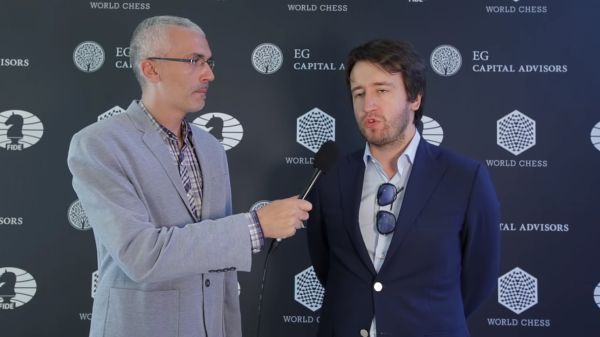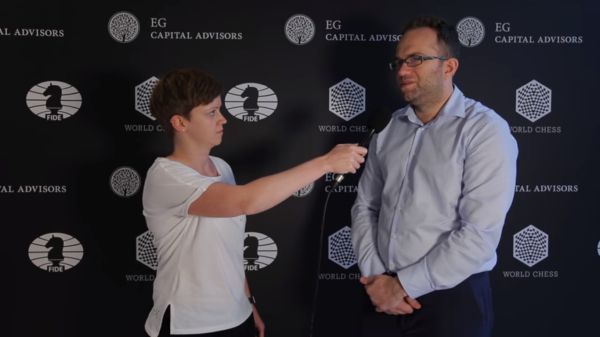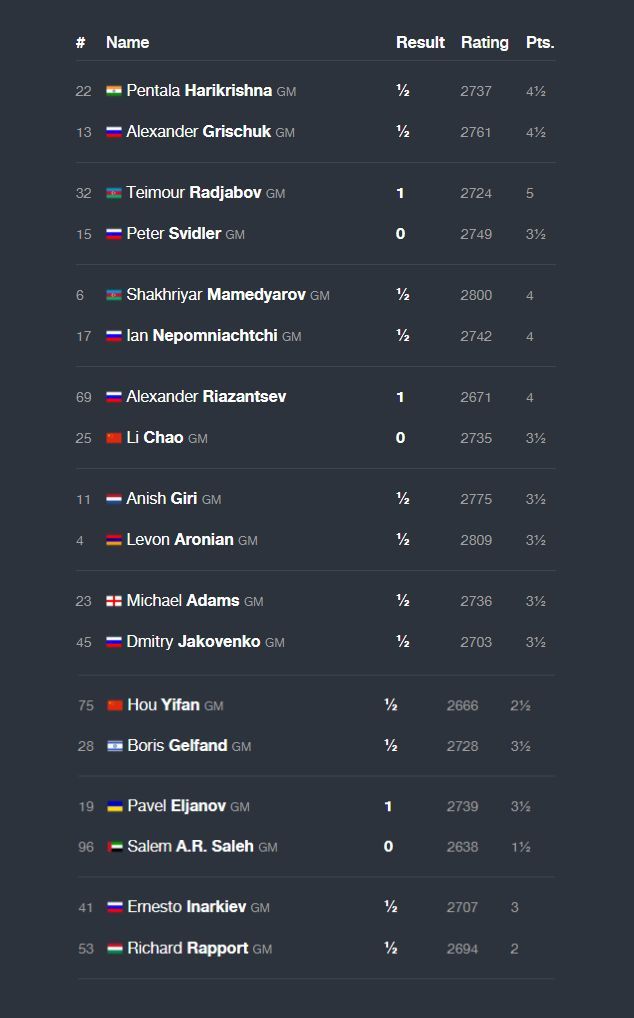Geneva Grand Prix Round 7: Radjabov overtakes Hari and Grischuk to take sole lead
After his win against Aronian in the previous round, India's Pentala Harikrishna had joined the lead along with Alexander Grischuk and Teimur Radjabov. In round 7, he was paired against one of his co-leaders, Grischuk and had the white pieces. This was a good opportunity for him to shoulder one of his opponents behind in this race towards the title. But this was not to be. Hari forgot some of his preparation and could only draw. While Radjabov, on the other hand, made the most of this opportunity by winning his game against Svidler. A detailed report with Hari's annotated game.
Approaching closer to the finish line, Azerbaijani GM Teimur Radjabov put on a spurt and defeated the six-time Russian Champion Peter Svidler in round 7. Before the round began, Radjabov was in joint lead with the Indian ace, Pentala Harikrishna, and the three-time world blitz champion, Alexander Grischuk. As Grischuk and Harikrishna were pitted against each other and agreed a draw, Radjabov made the most of his opportunity and beat Svidler to take sole lead. With only two rounds to go, the Azeri GM has put himself in a strong position to win the title prize with this victory.

Pentala Harikrishna had the white pieces against Alexander Grischuk in round 7 of the Geneva Grand Prix. The king’s pawn has been Hari’s favourite at this event apparently and he saw no reason to deviate from it against Grischuk. In response, the Russian essayed the Sicilian Najdorf, signalling his intent for a sharp fight. This was not the first time Hari had been confronted with the Najdorf in this event. He had also played on the white side of it against Radjabov’s compatriot, Shakriyar Mamedyarov, in round 3 and achieved a winning position. As he had done against GM Mamedyarov, Hari chose the 6. h3 line yet again. This line is a really sharp one wherein players tend to castle on opposite wings and storm their opponent’s monarch with their pawns. Considering that both players were tied for first, this was their chance to shoulder one of their co-leaders behind in the race to the title prize. A razor-sharp battle was expected.
[Site "Geneva"]
[Date "2017.07.13"]
[Round "7"]
[White "Harikrishna, Pentala"]
[Black "Grischuk, Alexander"]
[Result "1/2-1/2"]
[ECO "B81"]
[WhiteElo "2737"]
[BlackElo "2761"]
[Annotator "Tanmay Srinath"]
[PlyCount "58"]
[EventDate "2017.??.??"]
{This 7th Round Game pitted the two of the 3 leaders against each other, as
Harikrishna had white against Grischuk. A win here would see Hari take sole
lead in the tournament, and he gave it his all in a sharp Sicilian encounter.}
1. e4 c5 2. Nf3 d6 3. d4 cxd4 4. Nxd4 Nf6 5. Nc3 a6 {Grischuk plays his pet
Sicilian, the Najdorf. It is clear that he has come to the board in a fighting
mood.} 6. h3 {Hari again responds with 6.h3, the move he used against Nepo
with some success. Judging by this game, it seems he has prepared this line
very carefully.} e6 {An interesting choice by Grischuk, allowing the Keres
Attack with g4.} (6... e5 {is the main line, and after} 7. Nde2 h5 8. Bg5 Be6
9. Bxf6 Qxf6 10. Nd5 Qd8 11. Nec3 {we reach a balanced position, with chances
for both sides.}) 7. g4 {Judging by the reappearance of the Scheveningen at
the top level, I feel white should find a new idea in the Keres Attack.
Otherwise, black has acceptable positions to play.} Nfd7 {A prophylactic move,
planning b5, Bb7, and Nbc6, but not the main move.} ({Players in the past have
preferred the developing} 7... Be7 {but after} 8. g5 Nfd7 {white plays the
interesting} 9. Be3 $5 b5 ({Note that Bxg5 is bad, as after} 9... Bxg5 {
White plays the strong} 10. Nxe6 $1 fxe6 11. Qh5+ g6 12. Qxg5 Qxg5 13. Bxg5 Ne5
14. O-O-O $16 {and has the much better game.}) 10. a3 Bb7 11. h4 Nc6 12. Rg1
$14 {and white is to be preferred, Ganguly-Salem Saleh.}) ({The prophylactic}
7... h6 {can also be considered, trying to prevent the g5 advance. But if
white plays it anyway, why bother with such a waste of time? After} 8. f4 Nc6
9. Be3 Qc7 10. Bg2 Be7 11. Qe2 $14 {White has acres of space and free
development, and looks forward to increasing his substantial advantage.}) 8. g5
b5 {Grischuk plays principled chess, trying to get counterplay on the
queenside.} 9. a3 {Here, the prophylaxis makes much more sense, as white buys
time to play f3 later, and close the diagonal.} Be7 10. h4 Bb7 11. Be3 Nc6 12.
Qd2 Rc8 13. Nxc6 Bxc6 14. h5 $146 {A novelty by Hari, and a logical one as
well. White plans to storm the castle with g6.} O-O 15. O-O-O $16 {Both sides
have completed their development logically. My assesment is that white is
better, due to his faster play on the kingside. Black must seek counterplay
soon.} Nc5 16. f3 a5 17. Bxc5 $6 {A questionable exchange. The bishop was
doing fine on e3, and the knight was not that powerful.} ({It was time for the
prophylactic advance} 17. b4 $1 $16 {Somehow, Hari keeps missing this in his
games this tournament. Sure, this might look risky, but then, it prevents b4,
and blocks off the b-file. After} axb4 18. axb4 Na4 19. Nxa4 bxa4 20. Ba6 Qc7
21. h6 g6 22. Qc3 $16 {White holds all the trumps.}) 17... dxc5 18. Qxd8 $6 {
A negative mindset by Hari, wanting to exchange queens and draw as soon as
possible.} ({On any other day, he would have gone} 18. Qe3 {and after} Qb6 19.
g6 Rfd8 20. h6 $36 {White retains some chances.}) 18... Rfxd8 {The players now
play a few more moves, and then agree to a draw.} 19. Bxb5 Bxg5+ 20. Kb1 Ba8
21. Na4 Be7 22. b3 Rb8 23. Rxd8+ Rxd8 24. Nb2 Bf6 25. Nd3 Bd4 26. Rd1 Rd6 27.
Rc1 f5 28. c3 Be3 29. Re1 Bd2 {and the players drew. A good result for the
Russian Grandmaster, who maintains his +2 score, and keeps sight of Rajdabov,
who again won today. As for Hari, I am upset that he failed to find the right
pawn push(b4). Had he done so, he would have pushed his opponent harder, and
could have caught up with Rajdabov on +3. He really needs to improve his
performance with white in this tournament if he needs to stand a chance.}
1/2-1/2

With this game drawn, Teimur Radjabov, the third co-leader before round 7, got an opportunity to overtake his nearest rivals. He had come to the board with the clear plan of getting Peter Svidler, his opponent, out of his comfort zone by going for a quiet position. Playing on the white side of a Symmetrical English Opening, the Azerbaijani GM traded queens as early as move six and kept a minimal edge in the position. As play progressed, Radjabov was able to exchange another set of minor pieces and open up the queen rook file in order to infiltrate with his rooks. By this time, Svidler’s position – although, objectively, within the realms of a draw – was quite difficult to defend due to pawn weaknesses. While Svidler tried to find the best defences, Radjabov was able to come up with a nice combination that led to a loss of a piece for his opponent. At this point, Svidler had seen enough and decided to show the white flag.
[Site "Geneva"]
[Date "2017.07.13"]
[Round "7"]
[White "Radjabov, Teimour"]
[Black "Svidler, Peter"]
[Result "1-0"]
[ECO "A34"]
[WhiteElo "2724"]
[BlackElo "2749"]
[Annotator "TA"]
[PlyCount "61"]
[EventDate "2017.??.??"]
b4 c4 8. Bb2 Bxb4 9. Bxg7 Rg8 10. Be5 Nc6 11. Bg3 Bf5 12. Be2 Be7 13. O-O h5 {
1/2-1/2 (79) Nepomniachtchi,I (2767)-Harikrishna,P (2766) Wijk aan Zee 2017})
6. dxc3 {A34: Symmetrical English: 2 Nc3, lines with ...d5} Qxd1+ 7. Kxd1 {
LiveBook: 8 Games} Bf5 8. Nd2 {White has an edge.} Nc6 9. e4 Be6 $146 ({
Predecessor:} 9... Bd7 10. Kc2 O-O-O 11. Nc4 f5 12. Be3 e5 13. g3 {1/2-1/2 (54)
Margvelashvili,G (2548)-Georgescu,T (2396) Kazan 2013}) 10. Kc2 g6 11. Bc4 Bd7
12. Nb3 b6 13. a4 Ne5 14. Bb5 a6 15. Bxd7+ Nxd7 16. Be3 e6 17. Rhd1 O-O-O 18.
Nd2 Be7 {[#]} 19. Nc4 $1 Kb7 20. a5 Rhf8 {intending ...b5.} 21. axb6 Nxb6 22.
Na5+ Kc7 23. Bf4+ Bd6 24. Bh6 {Threatens to win with Nb7!} (24. Rxd6 Rxd6 25.
Rd1 Nc8 $1 $15 {This is a strong move, after which Black is alright.} (25...
Rfd8 26. Rxd6 Rxd6 27. Bxd6+ Kxd6 28. Nb7+ Kc6 (28... Kc7 29. Nxc5) 29. Nd8+
$18) 26. b4 $5 cxb4 27. c4 g5 $1 (27... Kb6 28. c5+ Kxc5 29. Nb7+) 28. Bg3 e5
29. Bxe5 f6 30. Bg3 f5 $5 31. Bxd6+ (31. exf5 Rxf5 $13) 31... Nxd6 32. e5 {
And White is better here, but it is already a mess (Aditya Pai).}) 24... Rfe8
25. Nb3 Ra8 26. Be3 Nd7 27. Ra5 Kc6 28. Rda1 Kb6 29. R5a4 Rec8 30. Na5 Be7 $2 {
[#]} (30... Kc7 $16 {is a better chance.} 31. Nc4 Nb6) 31. Rb4+ {Precision:
White = 97%, Black = 55%.} 1-0
The game between Alexander Riazantsev and Li Chao was an exhausting 84-move-long battle in which the former was able to draw blood out of stone. Kicking off with the Schlechter variation of the Gruenfeld Defence, Riazantsev was able to isolate Chao’s queen’s pawn and win it. But the Chinese GM sought counterplay against his opponent’s queen rook pawn and grabbed it eventually to neutralise Riazantsev’s advantage. In the process, the players exchanged several pieces and the resulting endgame looked completely equal. But the Russian GM kept shuffling his pieces waiting for his opponent to commit a mistake. His patience paid off on the 63rd move when Chao wore out and played an inaccurate move with his king that allowed Riazantsev to exchange rooks. Both players were able to queen their pawns in the ensuing position but the fact that Riazantsev was also able to win a pawn amid all this, turned the tables in his favour.



After the ante-penultimate round, Teimur Radjabov, with a score of 5.0/7 is the sole leader. Harikrishna and Grischuk are right behind on 4.5/7. Shakhriyar Mamedyarov and Ian Nepomniachtchi share the third place with 4.0/7. Eight players – Aronian, Giri, Svidler, Eljanov, Adams, Li Chao, Gelfand and Jakovenko – share the fourth spot having scored 3.5/7. Inarkiev (3.0/7), Hou Yifan (2.5/7), Rapport (2.0/7) and Saleh (1.5/7) are on fifth to eighth spots respectively.
Also on ChessBase India
Geneva Grand Prix Round 1 & 2: Hari off to a great start!
Geneva Grand Prix Round 3: Hari misses a big chance against Mamedyarov
Geneva Grand Prix Round 4: Hari maintains his second spot; holds Radjabov to a draw
Geneva Grand Prix Round 5: Grischuk joins Radjabov in the lead; Hari draws Nepomniachtchi
Geneva Grand Prix Round 6: Harikrishna stuns Levon Aronian!
Coverage on Firstpost
Firstpost and ChessBase India have collaborated to bring you extensive and detailed coverage of the chess scene in India and internationally.
The Geneva Grand Prix 2017 has been covered extensively by Aditya Pai for both ChessBase India and Firstpost.
Geneva FIDE Grand Prix: P Harikrishna beats Alexander Riazantsev after 84-move grind in round one
Geneva Grand Prix, Round 4: P Harikrishna stays second after 20-move draw against Teimur Radjabov
Geneva Grand Prix, Round 5: P Harikrishna draws vs Ian Nepomniachtchi; Alexander Grischuk joint top
Geneva FIDE Grand Prix: P Harikrishna cutting Levon Aronian to size the highlight of round six

